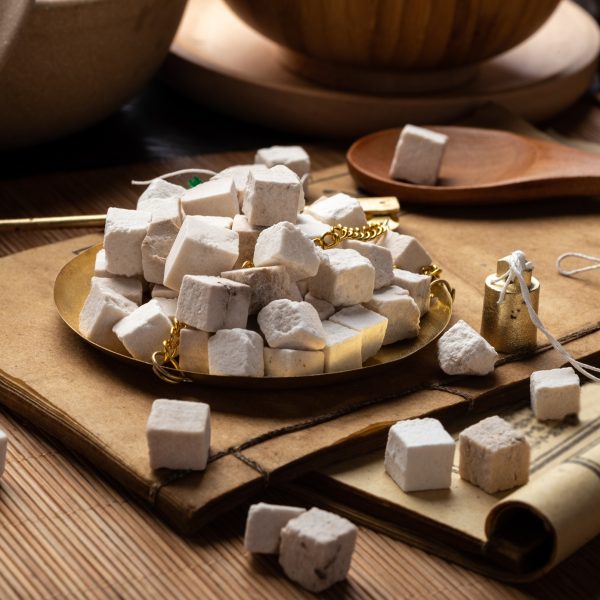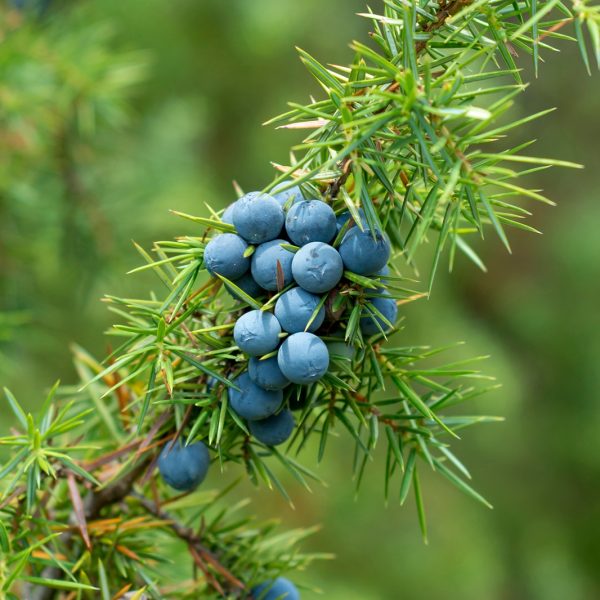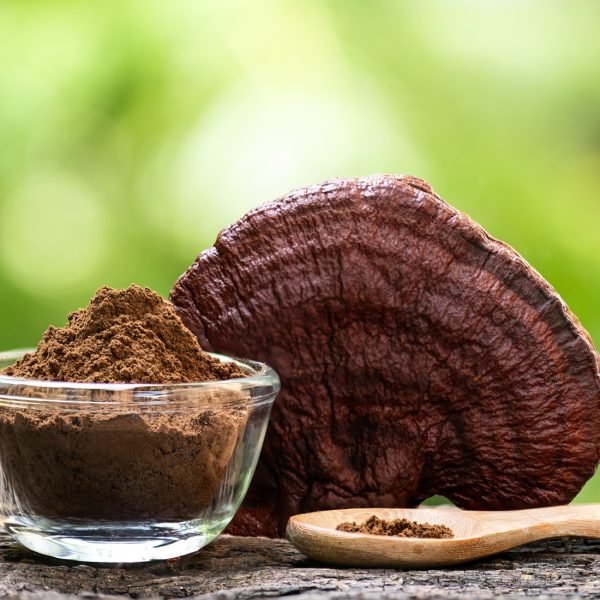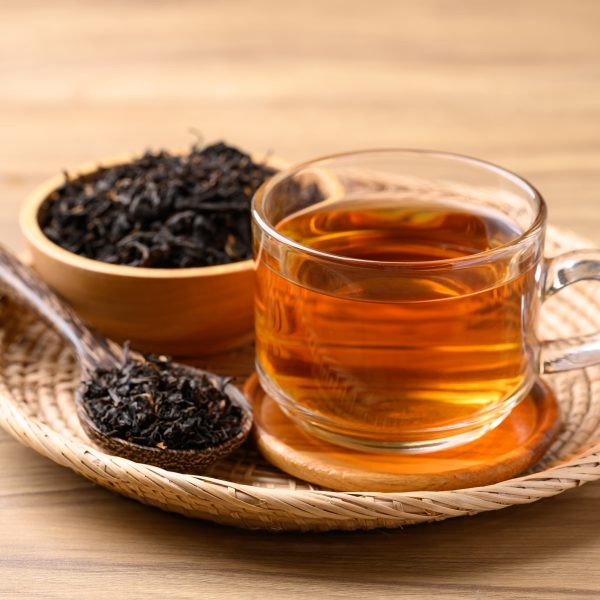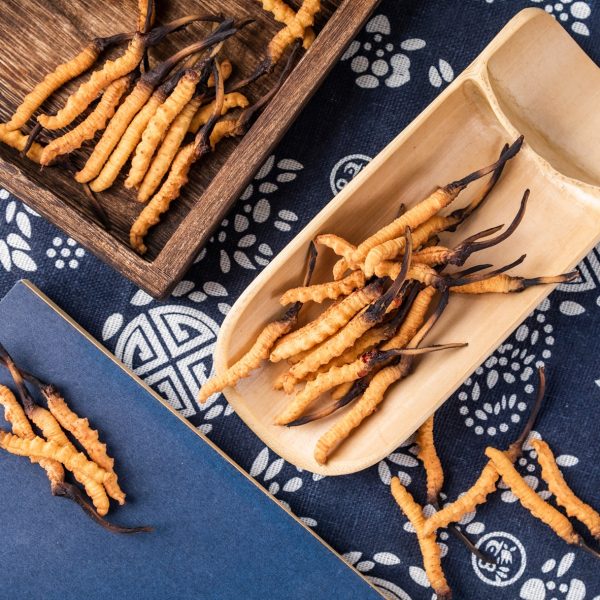-
How does it feel?
Lily of the valley tincture has a sweet, floral and slightly spicy aroma, which is charming and inviting. The tincture is pleasant tasting, sweet with a mildly sharp and astringent aftertaste. It feels gently warming and has a calming quality if you sit quietly and feel it moving through the body. After a few days of taking small (drop) doses you may notice a slight shift in any anxiety, low mood or restlessness and a slight elevation in vitality.
-
What can I use it for?

Lily of the valley (Convallaria majalis) Lily of the valley is included on a list of the Schedule 20 Part 2 herbs in the European Human Medicines Regulation 2012 (1). These herbs may only be used by a qualified medical herbalist in their prescriptions, following a one-to-one consultation, and are not permitted for general sale (1). Lily of the valley is not suitable for home remedies and is not recommended for use without the guidance of a qualified medical herbalist.
Lily of the valley is a cardiotonic, coronary vasodilator and hypertensive. It is primarily used in cases of congestive heart failure due to a weakened heart muscle, or mechanical defects with the heart valves, and peripheral oedema of cardiac origin. Lily of the valley strengthens and tones the cardiac muscle, allowing for a more efficient pumping action, regulating the heart rate without putting extra demand on the coronary vessels (2,3). This improvement in the rhythm and power of the heartbeat increases the blood pressure and improves tonicity throughout the entire circulation (2). Lily of the valley also has a diuretic action on the kidneys, and is primarily indicated in cases of congestive heart failure where there is fluid build-up in the heart and oedema in the periphery.
-
Into the heart of lily of the valley

Lily of the valley (Convallaria majalis) The cardiac glycosides are the main active constituents in lily of the valley. These exert their action by having a positive inotropic effect (intrinsic increase in the strength of the myocardial contraction) on the cardiac muscle cell (myocyte) membrane. Cardiac glycosides act directly on the extracellular (external) cardiac myocyte membranes to inhibit the sodium/potassium ATPase (Na+/K+ ATPase) enzyme (4). This enzyme maintains the normal negative resting membrane potential of the myocytes by continuously pumping sodium (Na+) out of the cell in exchange for potassium (K+) being pumped back into the cell. This maintains the normal excitability of the cell membrane with Na+ on the outside and K+ on the inside of the cell.
As part of this normal process, Na+ is also exchanged with calcium (Na+/Ca++ exchanger), reducing the Ca++ inside the cell after each muscle contraction (4). Inhibition of the Na+/K+ ATPase by the cardiac glycosides leaves less Na+ available to be exchanged with Ca++ and, therefore, more Ca++ remains inside the myocyte (4). This increased intracellular level of Ca++ enhances muscle contractility and the force of the muscle contraction (positive inotropy) without the need for more energy or oxygen (5,6). Effectively, the heart beats more blood, more efficiently, without needing to speed up or use more oxygen (7). This increased cardiac output leads to a decrease in heart rate (negative chronotropic action), increased blood pressure (hypertensive action) and increased blood flow. Cardiac glycosides also act directly on the Na+/K+ ATPase in the central nervous system, activating the parasympathetic nervous system to decrease heart rate (4).
The cardiac glycosides also decrease the conduction speed of the atrio-ventricular junction (negative dromotropic effect), which slows the heart rate and has an anti-arrhythmic effect on atrial arrhythmias, including atrial fibrillation (6,8). However, the therapeutic ratio of cardiac glycosides is low, meaning the dose needed to exert an effect is close to the toxic dose. In excess, cardiac glycosides can inhibit too much Na+/K+ ATPase, which can lead to atrial and ventricular myocardial excitability. This indicates that arrythmias and bradycardia (low heart rate) are possible side effects, and indications of toxicity (7). Also, low blood K+ levels cause the cardiac glycosides to bind increasingly to the cell membrane, and the Na+/K+ ATPase pump is excessively inhibited, causing the same indications of toxicity (4).
The diuretic action of lily of the valley occurs via two mechanisms. Firstly, the increased blood flow helps to transfer fluid from the tissues to the kidneys to be excreted, and the increased blood pressure through the kidney has a beneficial effect on diuresis. Secondly, the cardiac glycosides act directly on the kidney to limit the reabsorption of Na+ from the kidney tubules, which increases the excretion of fluid in the urine (4).
Regarding energetics and the essence of the plant, Culpeper stated that the spirit of the flowers restores lost speech, helps with palsy, and is exceedingly good for apoplexy (cerebrovascular accidents) to comfort the heart and the vital spirits (9). In traditional medicine, the vital spirits reside in the heart, which pumps these energies around the body, explaining the link between lily of the valley and vitality (10). Christopher Hedley describes lily of the valley as “a herb for the heart and spirits” (10). He stated that it works well in drop doses and can be used for supporting the emotional heart and disturbances in the vital spirits, such as anxiety, confusion, absent-mindedness, weak memory, and depression (10).
-
Traditional uses

Lily of the valley (Convallaria majalis) In the 1600s, Culpeper thought it a helpful herb to strengthen the brain and improve weak memory (9). Lily of the valley distilled water was dropped into the eyes to reduce inflammation, and an external application of the flowers was applied for gout (9).
Concurrent with its modern use, the main indication for lily of the valley was as a remedy for the heart. In 1898, King’s American Dispensatory included lily of the valley as a herb indicated for “heart irregularities due to mechanical impediments; mitral insufficiency; dropsy of cardiac origin; palpitation and vehement heart action, with arrhythmical movements, dyspnoea, and diminished arterial pressure; and quickened pulse with capillary obstruction” (11).
Lily of the valley was used as a tonic for the heart, strengthening and increasing the action of the heart (11). This favourable action on the heart and vessels was known to slow the heartbeat, establish normal rhythm, increase heart power, improve arterial pressure, and deepen respiration (11). Mitral insufficiency, with the associated dyspnoea and palpitations, were considered the primary conditions indicated for lily of the valley, as well as being recommended in the early stages of carditis (inflammation of the heart) (11). It was not recommended for heart irregularities due to organic degeneration, such as insufficiency or stenotic conditions of the aorta (11).
Owing to the actions upon the heart muscle and the diuretic action on the kidneys, it was also used in cases of dropsy (oedema) which were of cardiac origin (11,12). In these cases, cardiac debility causes cardiac inefficiency, poor circulation through the heart, feeble circulation, diminished blood pressure, dyspnoea, diminished renal action with an increase of solids in the urine as well as hepatic fullness and engorgement (11).
Lily of the valley was also used in cases of cardiac debility following severe and exhaustive diseases such as typhoid fever, to promote normal circulation, and relieve faintness upon standing (11). Ellingwood reported the use of lily of the valley for a case of heart failure with cardiac oedema, stating, “in the left and right ventricles there was found an extravasation of blood under the endocardium. Under its influence the quantity of urine is much increased, and dropsical exudates are promptly absorbed and the weight of the patient lessened. The pulse grows fuller, more regular, and slower” (2).
Owing to the diuretic action, lily of the valley was recommended in the form of a decoction of the flowers for removing obstructions in the urinary canal (13). It was also used as a tonic for the digestive tract, increasing the appetite and digestive power, and eliciting a slightly purgative effect (11). The powdered flowers were used in fomentations (compresses) for the removal of ecchymosed spots caused by bruises, epilepsy and worms. Miasmatic fevers were treated with the root (11). A tea made from the flowers was considered an excellent treatment against all nervous complaints, and a cure for nervous headaches, and trembling limbs (14).
While it was stated that lily of the valley is never contraindicated in proper doses, it was known to be “decidedly toxic, death having promptly occurred from suspension of the heart action when introduced directly into the veins of the rabbit” (11). Lethal doses were known to cause irregular cardiac action, with rapid and feeble pulsations; extreme slowing of respiration, significantly lowered blood-pressure, and finally arrest of the heart in systole, by direct stimulation of its inhibitory apparatus (12).
-
Traditional actions
Herbal actions describe therapeutic changes that occur in the body in response to taking a herb. These actions are used to express how a herb physiologically influences cells, tissues, organs or systems. Clinical observations are traditionally what have defined these actions: an increase in urine output, diuretic; improved wound healing, vulnerary; or a reduction in fever, antipyretic. These descriptors too have become a means to group herbs by their effects on the body — herbs with a nervine action have become the nervines, herbs with a bitter action are the bitters. Recognising herbs as members of these groups provides a preliminary familiarity with their mechanisms from which to then develop an understanding of their affinities and nuance and discern their clinical significance.
-
Traditional energetic actions
Herbal energetics are the descriptions Herbalists have given to plants, mushrooms, lichens, foods, and some minerals based on the direct experience of how they taste, feel, and work in the body. All traditional health systems use these principles to explain how the environment we live in and absorb, impacts our health. Find out more about traditional energetic actions in our article “An introduction to herbal energetics“.
Western energetics
-
What practitioners say

Cardiovascular system Cardiovascular system
Lily of the valley is a cardiotonic and coronary vasodilator, hypertensive, and anti-arrhythmic. It has a long history of use to support cases of congestive heart failure which are due to a myocardial insufficiency (weakened heart muscle), cardiomyopathies, and mechanical defects in the heart, such as valve disorders. These cardiac disorders result in dilation of the left ventricle without any compensatory hypertrophy as the heart muscle progressively weakens and becomes increasingly ineffective at pumping blood (15). Lily of the valley induces a positive inotropic action on the heart to restore strength and function, and efficient ejection of blood. This action increases the cardiac output without increasing the demand for oxygen by the heart muscle (5). This enables the heart to pump adequate amounts of blood around the body, preventing fluid from building up in the heart, lungs and periphery (16).
If there is fluid in the pericardium or lungs, the effect of lily of the valley will be quickly observed (2). Combined with the diuretic action on the kidneys, lily of the valley is ideally suited to congestive heart failure where there is oedema, low blood pressure and a weak or slow pulse. However, it is also indicated in cases of tachycardia due to a weak heart inefficiently ejecting blood and needing to beat more rapidly to compensate for the stroke volume. Lily of the valley is particularly effective when used in early congestive heart failure, combining well with hawthorn (Crataegus monogyna) and motherwort (Leonurus cardiaca) to mitigate the onset of full-blown heart failure (4,5,17).
Other indications for use include cardiac arrhythmias or bradycardia linked to mechanical heart defects (5). The cardiac glycosides in lily of the valley have a negative dromotropic action by decreasing the conductivity of the atrio-ventricular junction, which has an anti-arrhythmic effect on atrial arrhythmias (7). Great caution is warranted with this use since the therapeutic window is narrow, and toxicity can exacerbate arrhythmias. Lily of the valley can be used effectively to normalise the action of the heart, increase the rate and strength of the pulse in cases of bradycardia, and increase blood pressure in cases of hypotension (5,18). Bradycardia is common in the elderly, when the heart is weakened but is performing well when at rest. In these cases of mild bradycardic heart failure, lily of the valley is valuable to strengthen the heart. Lily of the valley can also be used for symptoms of cerebrovascular disorders in the elderly, including memory loss, confusion and fearfulness, and help with recovery from strokes (10).
Lily of the valley affects the circulatory system in a similar way to foxglove (Digitalis). Digoxin (the active constituent derived from foxglove) is a licensed medication used to treat certain heart conditions, including heart failure and irregular heartbeats such as atrial fibrillation (19). It works by strengthening the heart’s contractions and slowing the heart rate, helping the heart pump blood more efficiently. Digoxin requires careful dosing and has a narrow range of toxicity, causing symptoms like nausea, dizziness, and vision changes (20). Compared with foxglove, lily of the valley is generally as efficient as a heart tonic and diuretic, and in many cases may be a more suitable alternative (11). Lily of the valley is less toxic than other cardiac glycosides as it is poorly absorbed, has a short half-life, is rapidly excreted, and has no cumulative effects (4,15).
This results in less risk of toxicity and side effects than digitalis, which has an accumulative effect which can result in vomiting, anorexia, disordered digestion, cerebral excitation, and pupillary dilatation (11,12). Lily of the valley can be used by an experienced practitioner to wean off digoxin, though the process is nuanced and requires an individually tailored approach (4). When working with lily of the valley it is important to consider that many factors will influence individual toxicity limits, and dosing needs to begin conservatively and be monitored closely (4).

Respiratory system Respiratory system
Mitral valve defects and insufficiency often result in pulmonary congestion as the blood backs up into the pulmonary vessels. This results in pulmonary oedema and dyspnoea, which lily of the valley will resolve by improving the mechanical pumping action of the heart muscle. Therefore, lily of the valley will aid the body when there is difficulty breathing due to congestive conditions of the heart (16). Lily of the valley adds tone, power, vigour and regularity of action to the heart, and it supports the elimination of fluid from the respiratory tracts.
In addition to recommending the use of lily of the valley for mild cardiac insufficiency and heart insufficiency due to old age, the German Commission E recommended use for chronic cor pulmonale (21). Chronic cor pulmonale is a condition where the right side of the heart becomes enlarged and weakened due to long-term lung diseases such as COPD, pulmonary fibrosis, pulmonary embolism or pulmonary hypertension. The lungs create high pressure in the pulmonary arteries, forcing the right ventricle to work harder, leading to right-sided heart failure. Lily of the valley can strengthen the heart contraction and offer support throughout these respiratory disease processes, and once the heart begins to fail.
Respiratory illnesses such as viral infections, bacterial infections, tuberculosis, and prolonged fever, can result in congestion in the lungs, pulmonary effusion and an increased risk of developing endocarditis. In cases of endocarditis, lily of the valley combines well with echinacea (Echinacea angustifolia) and poke root (Phytolacca decandra) (5). In terms of providing holistic support to recovery from such illnesses, lily of the valley helps to overcome breathing distress, supports rest and sleep, and induces a general sense of improved wellbeing (2).
Musculoskeletal system
Lily of the valley has a secondary effect in supporting rheumatic conditions, especially when the heart is involved such as in rheumatic carditis or pericarditis (2). It serves a double purpose by strengthening and improving the tone of the heart, and supporting the elimination of metabolic waste and inflammatory mediators, which cause and worsen the inflammation.
-
Research

Lily of the valley (Convallaria majalis) There is a lack of clinical evidence to support the use of lily of the valley, and the indications for use are based on traditional use, in vitro research to determine the plant constituents, and the known actions of the constituents. Contemporary research has confirmed a positive inotropic effect of lily of the valley extracts in animal models (8).
Cytotoxic effects of the cardenolide convallatoxin and its Na, K-ATPase regulation
This study conducted in vitro research using animal cells to explore the cytotoxic effects of the cardenolide convallatoxin, and the mechanistic effects on Na,K-ATPase. The study demonstrated an inhibitory action of convallatoxin on Na,K-ATPase, supporting the mechanistic effect that lily of the valley has on regulating cardiovascular alterations seen in congestive heart failure and atrial arrhythmias. The study also found that convallatoxin induced cytostatic and cytotoxic effects and apoptotic cell death in non-small cell lung cancer (A549 cells). The study confirmed the mechanism of convallatoxin as an Na,K-ATPase inhibitor, and also suggests that it might work as an antitumour agent to help prevent and treat lung cancer (22).
-
Did you know?
Since the Middle Ages, the flowers have been traditionally used as part of a bride’s bouquet both for the floral scent, and their association with modesty and purity (3).
Additional information
-
Botanical description
Lily of the valley is a perennial, deciduous, rhizomatous plant which forms mats of extensive colonies (25,26). It grows to between 10–25 cm in height, each plant spreading to 50 cm wide (25).
Leaves appear in spring and remain in growth from April to September (25,29). The leaves are in pairs, which are broadly elliptic to narrowly ovate (25,27).
The erect flower stems appear between the pairs of leaves in May and June, and develop into arching racemes of small, nodding, bell-shaped, highly fragrant, creamy-white flowers (25,27).
Fruiting red berries develop in summer (25).
-
Common names
- Fairy Bells
- Convall lily
- Lady’s tears
- May bells
- May lily
- Mayflower
- Mugget
- Our Lady’s tears
- Word lily
- Male lily
- Lily confancy
- Ladder to Heaven
-
Safety
Lily of the valley is included on a list of the Schedule 20 Part 2 herbs in the European Human Medicines Regulation 2012 (1). In the UK these herbs may only be supplied by a qualified medical herbalist in their prescriptions following a one-to-one consultation, and are not permitted for general sale (1). There are no licensed products containing lily of the valley in the UK or Europe (19).
Symptoms of toxicity to be aware of when using lily of the valley include: nausea, vomiting, rapid pulse, facial flushing, cardiac arrhythmias, hypertension, restlessness, trembling, mental confusion, weakness, circulatory collapse, and diarrhoea (5,18). Lily of the valley is not known to have caused any human fatalities (23).
-
Interactions
Lily of the valley should not be taken alongside medications containing cardiac glycosides, such as digoxin, or other herbs containing cardiac glycosides (5,23).
Do not use with potassium depleting drugs such as non-potassium sparing diuretics, quinidine, quinine, corticosteroids or other medications intended to decrease blood pressure (4,10,16,24).
Avoid use with beta blockers due to the additive effect on bradycardia (10).
-
Contraindications
Lily of the valley should be avoided in cases of hypertension, as its action on the heart will increase blood pressure (18). Lily of the valley is not suitable in cases of potassium (K+) deficiency since low K+ levels cause the cardiac glycosides to bind increasingly with the myocyte membrane and the Na+/K+ ATPase pump becomes excessively inhibited, causing toxicity (4,5).
Avoid in pregnancy and when breastfeeding (5,16,24).
-
Preparations
- Tincture
- Infusion
- External poultice
-
Dosage
The Schedule 20 regulations state maximum legal doses of 150 mg per dose, 450 mg per day, and 3.1 g per week (1). The recommendations below are in accordance with these regulations (1).
- Tincture (1:8 | 45%): 1.2–3.6 ml per day (maximum single dose 1.2 ml), up to a maximum of 25 ml per week. For a 1:5 ratio tincture, this equates to 0.75–2.25ml per day (maximum single dose 0.75 ml), up to a maximum of 15.5 ml per week
- Fluid extract (1:1 | 45%): 0.15–0.45 ml per day (maximal single dose 0.15 ml), up to a maximum of 3.1 ml per week
- Infusion: 0.1–0.5 g per day
- Powdered herb: 0.6 g per day (21)
-
Plant parts used
- Aerial parts
- Leaf
- Flowers
-
Constituents
- Cardiac glycosides (0.1–0.5%): Convallotoxin (4–40%), convalloside (4–24%), convallatoxol (10–20%), desglucocheirotoxin (3–15%), andlokundjoside (1–25%) (4,5,23)
- Steroidal saponins: Progesterone (5,23)
- Flavonoids
- Amino acid: Asparagin, proline (16,23)
- Essential oils: Farnesol (16)

-
Habitat
Lily of the valley is native to the boreal and temperate regions of Europe, extending from the UK to Asia, although it is naturalised outside this native range (28). It was introduced and is naturalised across North America (11). It can be found growing in the wild in deciduous forests and woodlands with oak, ash and birch trees, roadsides, railways, cemeteries and churchyards (28,29). Due to the aesthetic appeal and highly fragrant flowers, lily of the valley is a common ornamental plant grown in private and public gardens.
-
Sustainability

Not currently on risk lists but complete data may be missing on the status of the species. Read more in our sustainability guide. The International Union for Conservation of Nature (IUCN) European assessment lists lily of the valley as “Least Concern” (28). A species is ranked as Least Concern (LC) when it has been evaluated against the criteria and does not qualify for Critically Endangered, Endangered, Vulnerable or Near Threatened. They state that the species is common and has a widespread distribution, and there are assumed stable populations and no major threats (28). It is considered not threatened in several national Red Lists, including the Vascular Plant and Red Data List(30).
Lily of the valley is reported as “secure” by Nature Serve since it is relatively common and well distributed across North America, and does not appear on either the U.S. or Canadian Endangered Species acts (32).
Lily of the valley is not listed by the Convention on International Trade in Endangered Species of Wild Fauna and Flora (CITES), so there is no legislation on the trade of this plant (31).
Habitat loss and over-harvesting from the wild are two of the biggest threats faced by medicinal plant species. There are an increasing number of well-known herbal medicines at risk of extinction. We must, therefore, ensure that we source our medicines with sustainability in mind.
The herb supplement industry is growing at a rapid rate and until recent years a vast majority of medicinal plant produce in global trade was of unknown origin. There are some very real and urgent issues surrounding sustainability in the herb industry. These include environmental factors that affect the medicinal viability of herbs, the safety of the habitats that they are taken from, as well as the welfare of workers in the trade.
The botanical supply chain efforts for improved visibility (transparency and traceability) into verifiably sustainable production sites around the world is now certificated through the emergence of credible international voluntary sustainability standards (VSS).
Read our article on Herbal quality & safety: What to know before you buy and Sustainable sourcing of herbs to learn more about what to look for and questions to ask suppliers about sustainability.
-
Quality control
Herbal medicines are often very safe to take; however, their safety and efficacy can be jeopardised by quality issues. So, it is important to buy herbal medicines from a reputable supplier, from sources known to test their herbs to ensure there is no contamination, adulteration or substitution with incorrect plant matter, as well as ensuring that recognised marker compounds are at appropriate levels in the herbs.
Some important quality assurances to look for are certified organic labelling, the correct scientific/botanical name, and the availability of information from the supplier about ingredient origins. A supplier should be able to tell you where the herbs have come from, what contaminants are not in the herb, and what the primary compounds are.
-
How to grow
Lily of the valley is propagated by seeds sown in containers in a cold frame as soon as the berries are ripe (25). However, the seeds are highly poisonous and rarely fully ripen, so propagation is better by root division in the autumn (3,25).
Lily of the valley grows well in fertile, humus-rich, moist soil and is suited to clay and loamy growing conditions (25). It prefers a sheltered spot and will grow in both full and partial shade, ideal for growing under trees or in the shade of a fence (3,25). The soil can be mulched with leaf mould in the autumn to protect the roots over the winter (25).
-
Recipe

Lily of the valley (Convallaria majalis) Splinter poultice*
A poultice is a mixture of fresh or dried herbs, mixed with water or oil and applied externally. The recipe uses fresh leaves to draw out a splinter or infection (18).
Ingredients
- 4–5 fresh lily of the valley leaves
Method
- Use a mortar and pestle to mash the leaves into a paste.
- Apply directly to the skin to draw out a splint or pus from a wound.
- Use a strip of muslin or cotton bandage to hold in place.
- Once the plant material dries, replace it if necessary until the splinter or pus has been removed.
* from Easley and Horne (18)
-
References
- UK Department of Health and Social Care. Banned and Restricted Herbal Ingredients. Published January 2023. Accessed April 14, 2025. https://www.gov.uk/government/publications/list-of-banned-or-restricted-herbal-ingredients-for-medicinal-use/banned-and-restricted-herbal-ingredients
- Ellingwood F. The American Materia Medica, Therapeutics and Pharmacognosy; 1919. Reprinted on Henritttas Herbpages. Accessed April 23, 2025. https://www.henriettes-herb.com/eclectic/ellingwood/convallaria.html
- McVicar, J. Jekka’s Complete Herb Book. Kyle Cathie Limited; 2009.
- Yarnell, E. Phytochemistry and Pharmacy for Practitioners of Botanical Medicine. Aeon books Ltd; 2019.
- Thomsen M. The Phytotherapy Desk Reference: 6th Edition. 6th ed. Aeon Books; 2022.
- Bone K and Mills S. Principles and Practice of Phytotherapy: Modern Herbal Medicine. Elsevier Health Sciences; 2013.
- Pengelly A. The constituents of medicinal plants: an introduction to the chemistry and therapeutics of herbal medicine. CABI Publishing; 2004.
- Ganora, L. Herbal Constituents: Foundations of Phytochemistry. Herbalchem Press; 2009.
- Culpeper N. Culpepers’ Complete Herbal: a book of natural remedies for ancient ills [1653]. Wordworth Reference; 1995.
- Waddell, G. Plant Medicine: A collection of the teachings of herbalists Christopher Hedley and Non Shaw. Aeon; 2023.
- Felter HW, Lloyd JU. Kings American Dispensary; 18th Edit; 1898. Reprinted on Henritttas Herbpages. Accessed April 22, 2025. https://www.henriettes-herb.com/eclectic/kings/convallaria.html
- Potter, SOL. A Compend of Materia Medica, Therapeutics, and Prescription Writing, 1902. Reprinted on Henritttas Herbpages. Accessed April 22, 2025. https://www.henriettes-herb.com/eclectic/potter-comp/convallaria.html
- Grieve M, Leyel CF, Marshall M. A Modern Herbal. the Medicinal, Culinary, Cosmetic and Economic Properties, Cultivation and Folk-Lore of Herbs, Grasses, Fungi, Shrubs & Trees with All Their Modern Scientific Uses. Dover Publications; 1982.
- Hill, J. The Family Herbal; 1812. Reprinted on Henritttas Herbpages. Accessed April 22, 2025. https://www.henriettes-herb.com/eclectic/hill/lily-valley.html
- Stansbury J, Saunders P, Winston D, Zampieron E. The use of Convallaria and Crataegus in the treatment of cardiac dysfunction. Journal of Restorative Medicine. 2012;1(1):107 https://restorativemedicine.org/journal/the-use-of-convallaria-and-crataegus-in-the-treatment-of-cardiac-dysfunction/?utm_source=ojs&utm_medium=web&utm_campaign=journal
- Hoffmann D. Medicinal Herbalism, The Science and Practice of Herbal Medicine. Healing Arts Press; 2003.
- Heinrich, M., Barnes, J., Prieto-Garcia, J., Gibbons, S. and Williamson, E.M. Fundamentals of Pharmacognosy and Phytotherapy. Third Edition. Elsevier Health Sciences; 2018.
- Easley T and Horne S. The Modern Herbal Dispensatory: A Medicine-Making Guide. North Atlantic Books; 2016.
- European Medicines Agency. Accessed April 14, 2025. https://www.ema.europa.eu/en/homepage
- NHS. Digoxin. NHS website. Accessed April 29, 2025. Available at: https://www.nhs.uk/medicines/digoxin/
- Blumenthal M, Busse WR. Lily of the Valley herb. In: The Complete German Commission E Monographs: Therapeutic Guide to Herbal Medicines. American Botanical Council; 1999. Accessed April 25, 2025. https://www.herbalgram.org/resources/commission-e-monographs/monograph-approved-herbs/lily-of-the-valley-herb/
- Schneider NF, Silva IT, Persich L, de Carvalho A, Rocha SC, Marostica L, Ramos AC, Taranto AG, Padua RM, Kreis W, Barbosa LA. Cytotoxic effects of the cardenolide convallatoxin and its Na, K-ATPase regulation. Molecular and cellular biochemistry. 2017;428:23-39. https://doi.org/10.1007/s11010-016-2914-8
- Fisher C. Materia Medica of Western Herbs. Aeon Books; 2018.
- Natural Medicines Professional Database. Therapeutic Research Centre. Lily of the Valley Professional Monograph. Published January 24, 2025. Accessed April 25, 2025. https://naturalmedicines.therapeuticresearch.com/
- Royal Horticultural Society. Convallaria majalis – lily of the valley. Accessed April 14, 2025. https://www.rhs.org.uk/plants/4327/convallaria-majalis/details
- Royal Botanical Gardens Kew (RBGK). Convallaria majalis L. Plants of the Word Online (POWO). Accessed April 23, 2025. https://powo.science.kew.org/taxon/urn:lsid:ipni.org:names:533487-1
- Blamey M, Fitter R, Fitter AH. Wild Flowers of Britain and Ireland: 2Nd Edition. A & C Black; 2013.
- Bilz M. IUCN Red List of Threatened Species 2013: Convallaria majalis (Europe assessment). Accessed on 14 April 2025. https://www.iucnredlist.org/species/202965/2758291
- Taylor I. Convallaria majalis L. in BSBI Online Plant Atlas 2020, eds P.A. Stroh, T. A. Humphrey, R.J. Burkmar, O.L. Pescott, D.B. Roy, & K.J. Walker. Accessed April 14, 2025. https://plantatlas2020.org/atlas/2cd4p9h.4zq
- Cheffings C, Farrell L, (eds), Dines, T.D., Jones, R.A., Leach, S.J., McKean, D.R., Pearman, D.A., Preston, C.D., Rumsey, F.J., Taylor, I. The Vascular Plant Red Data List for Great Britain. Species Status No. 7. Joint National Conservation Committee. 2005. Accessed April 14, 2025. https://hub.jncc.gov.uk/assets/cc1e96f8-b105-4dd0-bd87-4a4f60449907
- Convention on International Trade in Endangered Species of Wild Fauna and Flora (CITES). Accessed April 14, 2025. https://checklist.cites.org/#/en
- NatureServe explorer 2.0. Natureserve.org. Accessed April 14, 2025. https://explorer.natureserve.org/Taxon/ELEMENT_GLOBAL.2.797908/Convallaria_majalis
- UpS list of herbs & analogs. United Plant Savers. Published May 14, 2021. Accessed April 14, 2025. https://unitedplantsavers.org/ups-list-of-herbs-analogs/

